How to Convert Any Recipe To Sourdough | With Conversions
Learn how to convert any recipe to sourdough. You will love the added health benefits and complex flavors of all your favorite recipes.
Do you have some favorite recipes that you would like to convert to sourdough?
There are a lot of good reasons why you might like to do so. Once you follow a few principles and conversions, it actually isn’t complicated at all.
I am walking you through the steps and considerations to adapt any recipe to sourdough.
Why Sourdough?
You may be wondering why it’s worth converting any recipe to a sourdough recipe:
- you get the health benefits of sourdough
- you are not using commercial yeast
- it’s cheaper and more sustainable than purchasing yeast
- it pre-digests glutens which is good news for anyone with gluten sensitivity
- the baked goods have better and more complex flavors
- sourdough keeps bread fresh longer (made a video about that
- using sourdough connects you more to the dough (some think it’s a challenge) about the effects of temperature, time, and hydration levels
How to get started
Following these steps may help you to get started:
- Understand the type of recipe: is it yeast or baking powder/baking soda?
- Define your goals: are you looking to get the full health benefits of sourdough or just the flavor? This will make a difference for non-yeast recipes. Yeast recipes need longer fermentation time anyway therefore you will automatically get the benefits of a long fermentation. In order to get the sourdough flavor, your sourdough discard is perfect for quick breads and pancakes.
- Write out your recipe with the ingredients: This helps keep track of the ingredients. It also makes the math easier (I made a printable cheat sheet and conversion chart just for you).
- Obviously, you will need an active sourdough starter. You can check out my simple method to make a sourdough starter without discard.
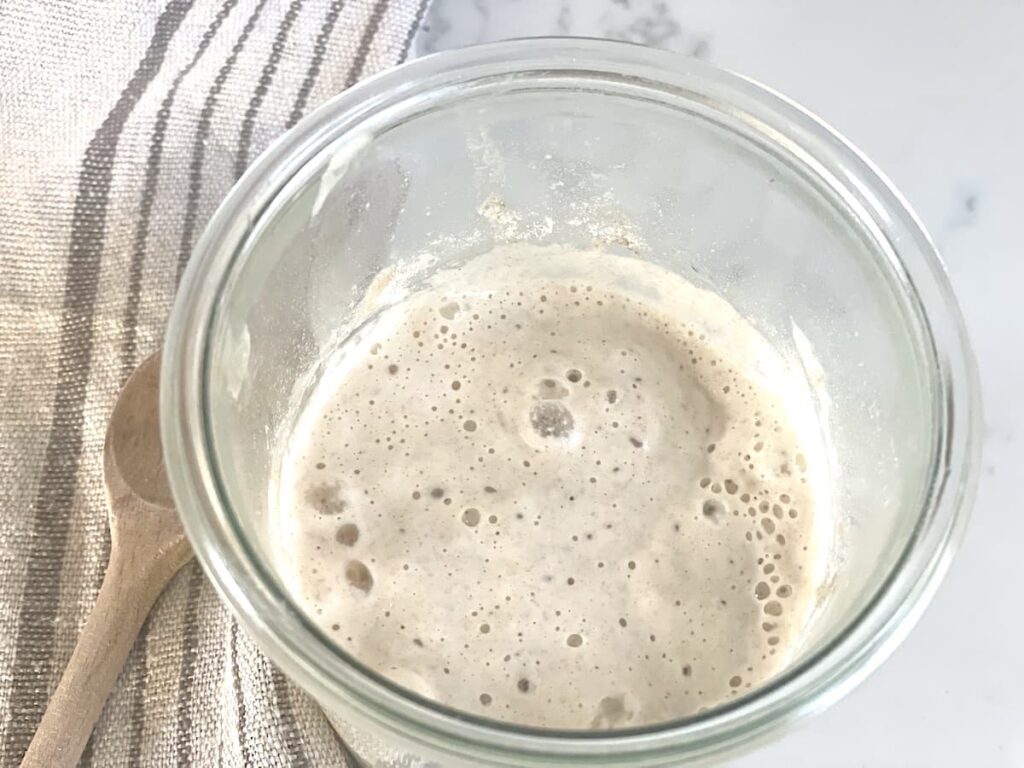
How to convert yeast recipes:
Making a sourdough version of your yeasted recipes is pretty straightforward. You see, a sourdough culture contains natural yeast already.
- Simply replace 1 pkg / 7g of yeast with 1 cup / 100 g of sourdough starter.
- Reduce flour by about ½ cup / 50 g and liquid by about ½ cup/ 50 g.
- Double the fermentation/rise time – possibly longer.
Note: This conversion assumes that your own sourdough starter is at about 100% hydration level, meaning it is half flour and half water in weight. You may have to adjust the amount of flour or extra water as necessary.
Example recipe:
| Yeast recipe | Sourdough bread recipe |
|---|---|
| 600 grams of flour or 5 cups | 550 g or 4 ½ cups of flour |
| 11 grams of sugar or 1 TBSP | not necessary |
| 7 grams of yeast or 1 pkg or 2 ¼ tsp yeast | 1 cup of sourdough starter |
| 15 grams of salt or 2 1/2 tsp | same |
| 380 grams of water or 1 2/3 cups | 330g or 1 ¼ cup of water |
| Bulk fermentation: 2 hours | 4+ hours |
| Second rise: 1 hour | 2+ hours |
TIPS
- Since commercial yeast is more active and reliable than a sourdough starter, I recommend you use warm water for your recipe. Also, make sure you have a very active sourdough starter. If you are fermenting your dough at room temperature, be sure to allow for at least twice the rising time.
- For best results, let the dough rise in a warm place. The second rise should go faster. You can also follow my tips on how to affect the sourness of your loaf of bread.
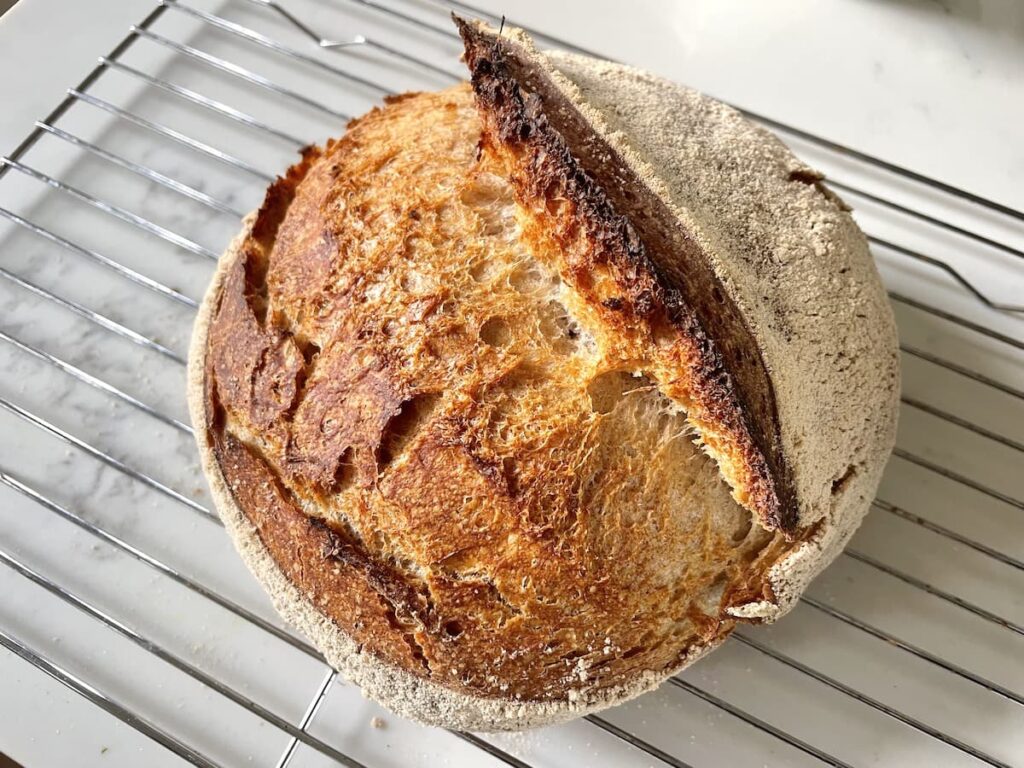
Here you can see how I converted my German soft pretzels into true sourdough pretzels
How to convert quick bread/cake recipes:
This conversion is a bit more complicated, as sourdough does not have the same leavening power as these chemical agents. Generally, you’ll need to use a combination of sourdough starter and an additional leavening agent to achieve the desired rise. Experiment with ratios based on the specific recipe, but a good starting point is to use 1/2 to 1 teaspoon of baking powder/baking soda along with 1 cup (240 ml) of sourdough starter.
- Determine if you’re going after the sour taste or if you are looking for a properly fermented recipe.
- If you’d like to have the sourdough taste, combine all the ingredients and bake according to the recipe.
- For a properly fermented quick bread, combine flour, liquid, and fat (if using) and let ferment for 4-8 hours.
- Add the remaining ingredients and leavening agents (baking powder or baking soda).
Example recipe:
| Irish Soda bread | Sourdough Irish Soda Bread |
|---|---|
| none | 1 cup sourdough starter |
| 4 TBSP butter | same |
| 1 whole egg | same |
| 1 ¼ cups buttermilk | ¾ cups buttermilk |
| 3 ½ cups flour | 3 cups flour |
| 1 TBSP sugar | same |
| 1 tsp baking soda | same |
| 1 ½ tsp sea salt | same |
TIPS
- For a longer fermentation, only mix the five ingredients and let the dough rest in the refrigerator for 5-8 hours. Then add the baking soda and salt right before baking. That way you get the maximum impact from the baking soda.
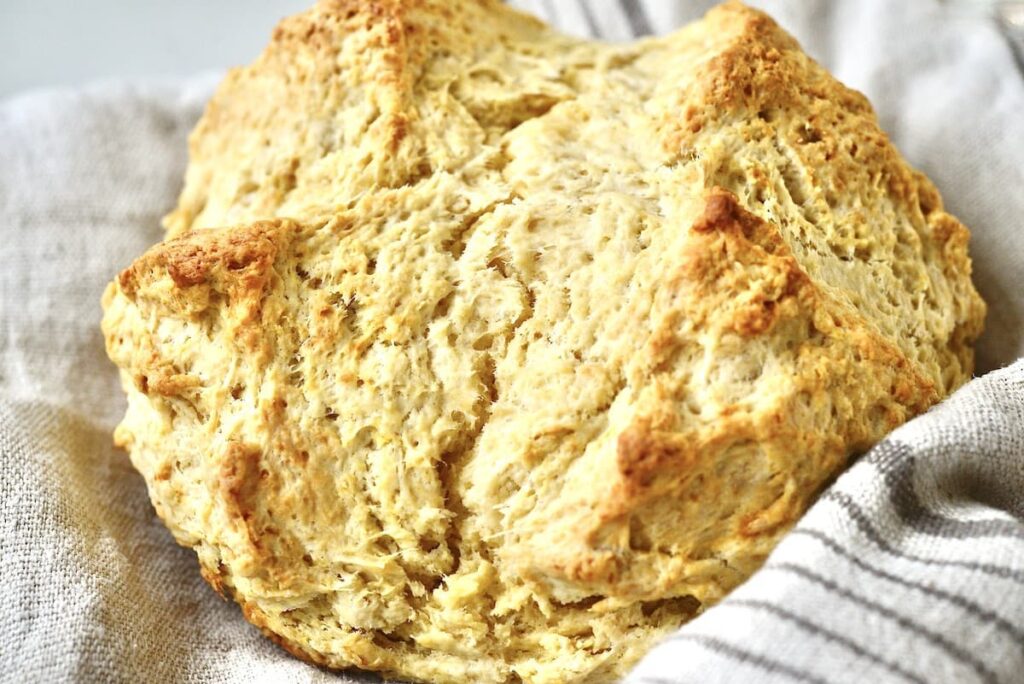
For pancakes, waffles, crepes:
Converting a pancake, waffle, or crepes recipe follows the same principles as for quick breads:
- Determine if you’re going after the flavor or if you are looking for a properly fermented recipe.
- If you’d like to have the sourdough taste, combine all the ingredients and bake according to the recipe.
- For properly fermented pancakes, combine flour, liquid, and fat (if using) and let ferment overnight.
- The next day, add the rest of the ingredients and leavening agents (baking powder or baking soda).
Check out this delicious sourdough waffle recipe.
TIPS
- This is also a good use for your sourdough discard – which has already been properly fermented.
- You can simply add eggs, sweetener, and some baking powder to your sourdough discard to make simple sourdough pancakes.
More Tips for Converting Any Recipe to Sourdough:
Experiment and adapt: Converting recipes to sourdough often requires experimentation and adjustment. It helps to keep notes of your conversions, including the amounts of ingredients used and the fermentation times. This way you can refine your process and achieve better results over time.
Remember that converting any recipe to sourdough is not an exact science, and the results can vary depending on many factors. The more you practice and gain experience with sourdough baking, the better you’ll become at adapting recipes to fit your sourdough starter’s characteristics.
I have converted a regular English muffin recipe to sourdough English muffins without having to tweak the recipe much.
Get your FREE conversion chart and cheat sheet here
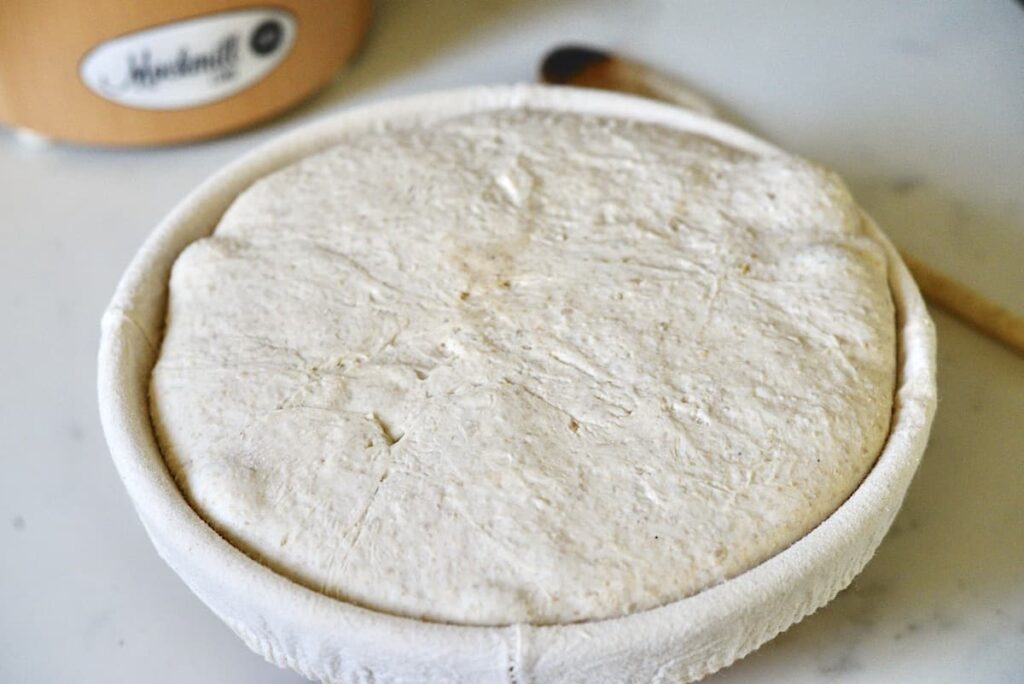
FAQ:
I recommend sticking to the original recipe. Whole grain flour can contribute to a more active fermentation process, leading to faster rising times. With sourdough, the additional nutrients in whole wheat flour can help feed the wild yeast and lactic acid bacteria. As a result, you get a more robust fermentation and deeper flavor development.
Since commercial yeast is much more reliable, I recommend adding at least double the time, probably more. Also, sourdough reacts much more to variables such as your own sourdough starter, temperature, and humidity. Therefore, I recommend watching your dough more closely and allow more ample time to let the dough ferment.
Yes, absolutely. Many sourdough purists will say that it is not a true sourdough bread if you add commercial yeast. However, I have a popular sourdough bread recipe that calls for a small amount of yeast. You still get the benefits of sourdough with guaranteed success.
Some people say that because of the amount of sugar, cake recipes are not well-suited for a longer fermentation. I have not personally experimented with this but will do so soon. So stay tuned!
Different doughs such as gluten-free or einkorn have lower levels or gluten and will behave differently than wheat-based recipes. You might have to experiment and make small adjustments over time to create your new favorite bread recipe.
In order to get the full health benefits of sourdough, the dough should be fermented for at least 8 hours. In that time, the “anti-nutrients” in the grains will be neutralized while the vitamin content will be increased. Grains will also be easier to digest (you can read more in Sally Fallon’s book “Nourishing Traditions“.
Let me know if you have any questions or comments!
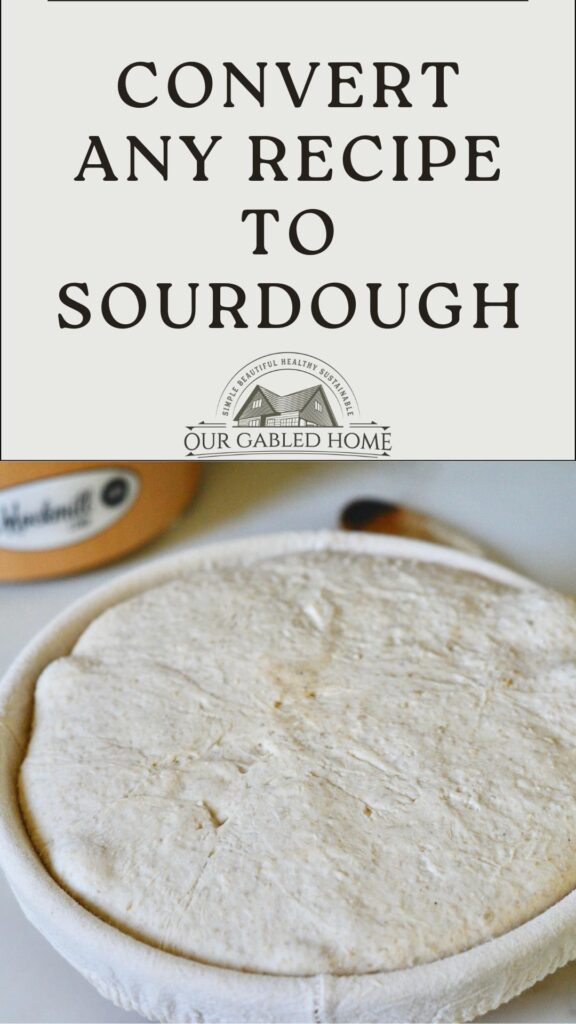


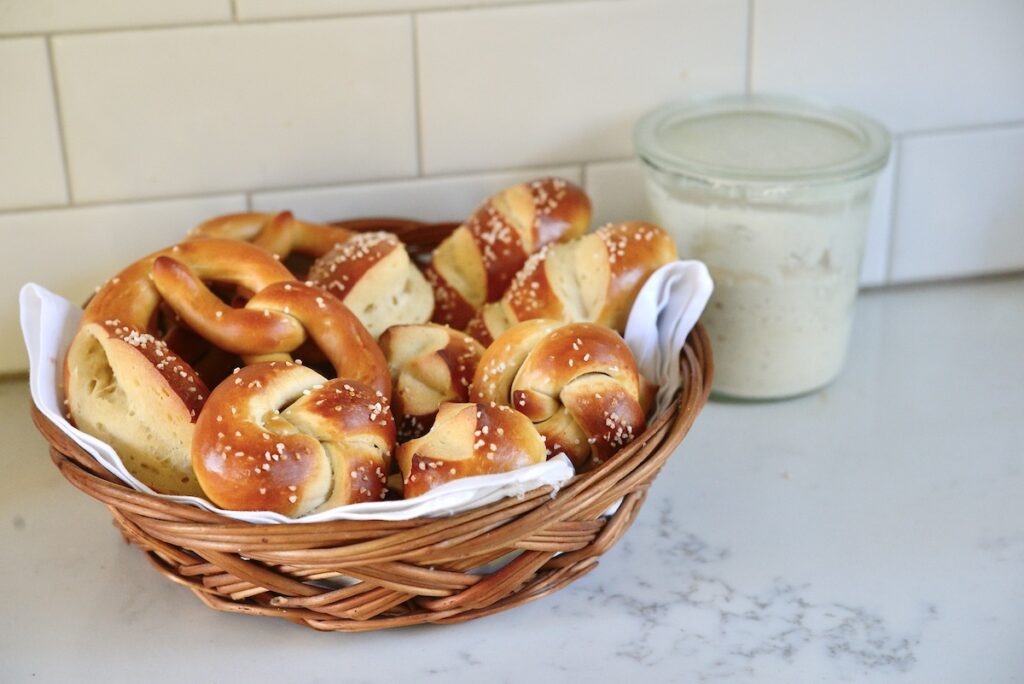
Love to hear more from you regarding sourdough recipes.
Thank you! I will continue to post sourdough recipes ~ Anja
I would love to receive more information about sourdough baking.
Thank you! I am always adding more sourdough recipes so keep coming back ~ Anja
I’m wanting to convert a chocolate chip cookie recipe..
It calls for 165 g of flour and as for liquids, 2 tsp (about 6 g) vanilla extract, and 110 grams of butter.
So does this mean i would do 115g of flour and 72 g of butter and vanilla extract?
How do i divide that up among the two liquids if this makes sense?
Unfortunately, the butter doesn’t exactly count as a liquid. I actually recommend you find a true sourdough chocolate chip cookie recipe instead of trying to convert your existing one ~ Anja
If I use your conversion but also wanted to add commercial yeast, do I use the amount of yeast the recipe calls for? or decrease it since using SD starter?
If I am adding yeast to my sourdough recipes, I only add a very small amount (think “pinch”) ~ Anja
Thank you so much for this. The recipe I am looking to convert is for empanadas and does not contain yeast or baking soda/powder. It is just flour (360 gm), sugar (2 Tblsp), oil (1/2 cup), water (1/2 cup), and salt (1/2 tsp). Do you have any advice on how I would make this long fermented?
I would replace the water and ½ cup of flour with one cup of SD starter ~ Anja
A lot of other bakers say 1 cup of 100% sourdough starter weighs 200 grams or more. Why do you use a different weight?
It always depends on who you ask and what hydration your sourdough starter is. You will have to adjust your recipe a bit to account for that. Hope that helps ~ Anja